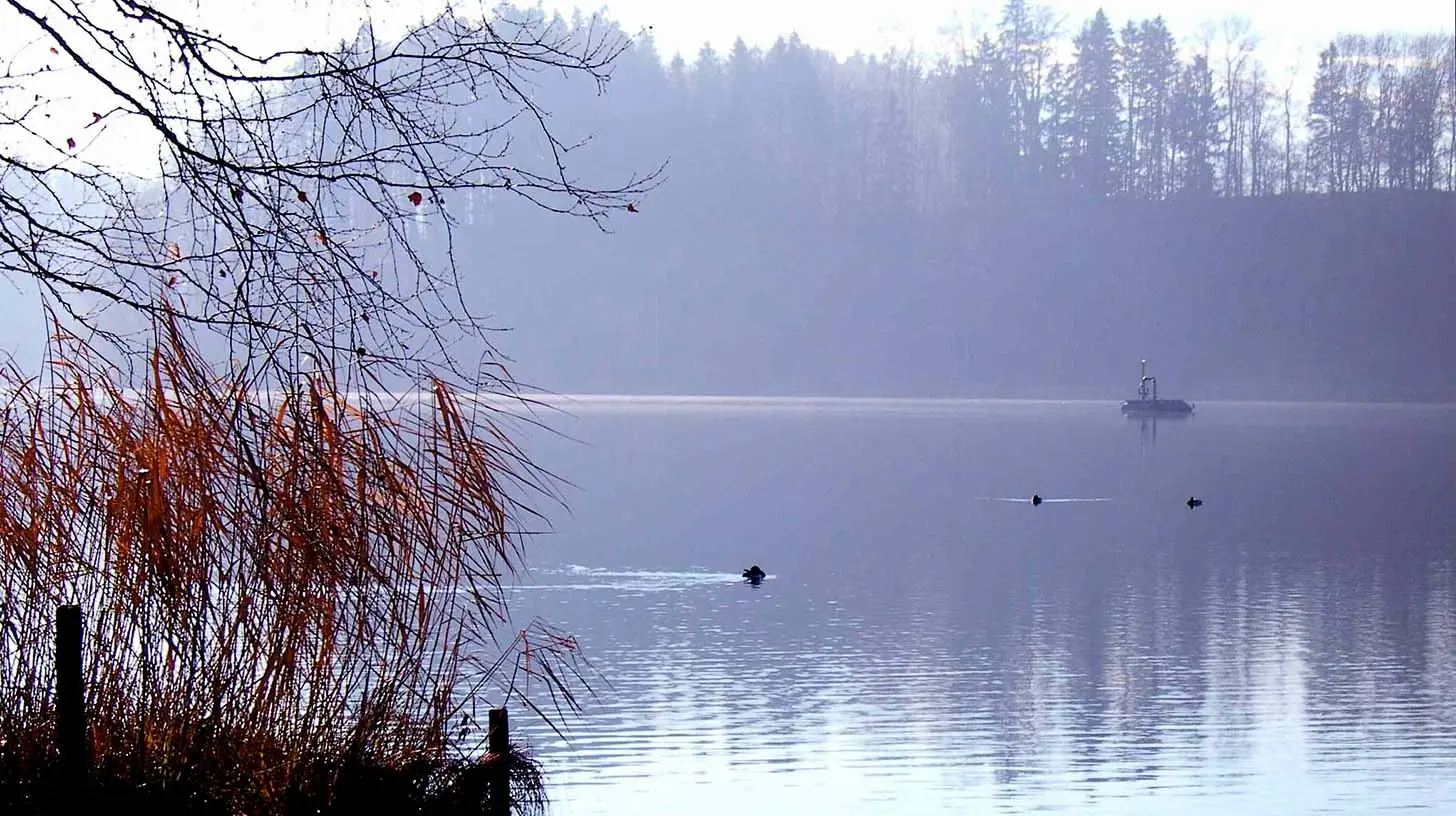

Schweizerisches Sagenbuch. Nach mündlichen Überlieferungen, Chroniken und anderen gedruckten und handschriftlichen Quellen.
by C. Kohlrusch
Leipzig 1854
The Chriemhild Trench
A wandering scholar, having learned sorcery in Salamanca1, traveled the world with the devil’s aid. On his journey, he arrived at Türlersee2, where a woman named Chriemhild3 lived. She was known for her beauty but was also wicked and envious, especially of her neighbors’ more fertile lands.
Chriemhild, long desiring to unleash her spite on her neighbors’ property, found the scholar’s arrival opportune. Hoping his magic could render their lands barren, she approached him. The scholar, smitten by her beauty, agreed to her wicked request.
One night, he began digging a large ditch, intending to divert Türlersee’s waters onto the neighbors’ fields, turning their fertile grounds into cold, wet marshland. The malevolent plan was nearly complete, but a pious pilgrim, recognizing the evil deed, intervened. With holy will, he banished the scholar and Chriemhild to Glärnisch4. They were condemned to create a garden on its icy peaks, known as Vreneligärtli or St. Verena’s Garden, named after the pilgrim who was believed to be Saint Verena5. Redemption for the pair will only come upon the garden’s completion, an unlikely event, as unlikely as the completion of the malicious ditch, now known as “Chriemhildengraben.”
Note: On maps, at the end of Türlersee’s southwestern bay, one finds the “Häxengraben” (Witch’s Trench).
-
Salamanca is a municipality and city in Spain located in the autonomous community of Castile and León. The origins of the city date back to about 2700 years ago, during the first Iron Age, when the first settlers of the city settled on the San Vicente hill, on the banks of the Tormes. Since then, the metropolis has witnessed the passage of various peoples: Vaccaei, Vettones, Romans, Visigoths and Muslims. Raymond of Burgundy, son-in-law of King Alfonso VI of León, was in charge of repopulating the city. In 1218, Alfonso IX of León founded the University of Salamanca, the oldest University in Spain, as a studium generale. It went on to become the of such places in Europe to hold the title of university by royal decree of Alfonso X of Castile dated November 9, 1252 and by the licentia ubique docendi of Pope Alexander IV of 1255. During the time when it was one of the most prestigious universities in the West. ↩
-
There is a legend on how this lake was formed: Where the Türlersee now stretches, in ancient times there lay a beautiful farm with fertile fields. The owner had a single child, a graceful and lovely daughter. She caught the eye of the young lord of Schnabelburg Castle, and he passionately pursued her. However, the honorable girl steadfastly rejected all his promises. <p> The castle lord then persuaded the father to bring the girl to the castle at midnight under various pretenses. He himself opened the gate and pulled the reluctant girl inside. As he was about to close the gate, she realized what was happening and let out a curse against her treacherous father. At that moment, a fiery lightning bolt struck from the sky, hitting her parental home. She saw a fiery chasm open, and the once splendid and blessed farm with all its fields disappeared into it. By morning, in their place lay a lake. ↩
-
Chriemhild is a form of Kriemhild who is also known as Gurdrun. She is a major figure in Germanic heroic legend and literature where she is the wife of Sigurd/Siegfried. She is believed to have her origins in Ildico, last wife of Attila the Hun, and two queens of the Merovingian dynasty, Brunhilda of Austrasia and Fredegund.<p>In both the Continental (German) and Scandinavian traditions, Gudrun/Kriemhild is the sister of the Burgundian king Gunther/Gunnar and marries the hero Siegfried/Sigurd. Both traditions also feature a major rivalry between Gudrun and Brunhild, Gunther’s wife, over their respective ranks. In both traditions, once Sigurd has been murdered, Gudrun is married to Etzel/Atli, the legendary analogue of Attila the Hun. In the Norse tradition, Atli desires the hoard of the Nibelungen, which the Burgundians had taken after murdering Sigurd, and invites them to his court; intending to kill them. Gudrun then avenges her brothers by killing Atli and burning down his hall. The Norse tradition then tells of her further life as mother of Svanhild and enemy of Jormunrekr. In the continental tradition, Kriemhild instead desires revenge for her brothers’ murder of Siegfried, and invites them to visit Etzel’s court intending to kill them. Her revenge destroys both the Huns and the Burgundians, and in the end she herself is killed.<p>In Richard Wagner’s Der Ring des Nibelungen, Siegfried’s wife is known as Gutrune. As Wagner’s cycle ends with Siegfried’s funeral and its immediate aftermath, it does not include her marriage to Atli/Etzel or revenge for Siegfried’s death. ↩
-
The Glärnisch is a mountain in the Swiss Alps, overlooking the valley of the Linth in the Swiss canton of Glarus. According to local legend, the glacier field at Vrenelisgärtli is where Saint Verena once wanted to create a garden. It is said that Verena, her garden, and the rock bowl her garden were planted in was eventually buried and has remained there ever since. This cooling of mountain corresponds to the cooling of temperatures in Central Europe from around 1300. The glacier field completely melted in the summer of 2003, and as of yet, no remnants of Verena, the garden, or the bowl have been found. ↩
-
Verena of Zurzach, mostly just called Saint Verena (c. 260 – c. 320) is an early Christian consecrated virgin and hermit. She is especially venerated in Switzerland, where her cult is attested in Bad Zurzach, the reported place of her burial, from at least the 5th century. She is recognized as a saint in the Roman Catholic Church as well as in the Eastern Orthodox Church and the Oriental Orthodox Churches. Her feast is on 1 September.<p>The oldest tradition of the life of Verena is found in the so-called Vita prior by Hatto, the abbot of Reichenau (and later bishop of Mainz), written in c. 888. The younger Vita posterior was most likely written by a monk in Zurzach in the 11th century, the oldest extant copy dating to the 12th century.<p>According to Hatto’s account, Verena was born in Thebes as the daughter of a notable Christian family. She was educated by a bishop named Chaeremon, who Eusebius recoded as being martyred in 250.<p>After the death of Chaeremon, Verena traveled to Lower Egypt with a group of Christians, where the Theban Legion was being recruited. With the Theban Legion, she then travelled to Milan, in what is today Northern Italy. While still in Milan, she heard of the martyrdom of the Theban Legion, traditionally dated to 286 and traveled to Agaunum, today a city called Saint-Maurice in Switzerland. Some stories say that she buried the martyred legionnaires.<p>Verena then moved on to Salodurum, a a city called Solothurn in Switzerland, in a hermitage, and spent her days in fasting and prayer, and working miracles. Hatto presents her as a prototype of the consecrated virgin, saying that she attracted a following of young virgins. She was at one point imprisoned by a local governor, and Saint Maurice appeared to her in jail to console and strengthen her. After she was released, she continued her good works. At the end of her natural days, she retired into a narrow cave.<p>The year of her death was calculated as 344. If her birth before 250 is accepted, based on the identification of her mentor, bishop Chaeremon, this would imply that she was more than 95 years old at the time of her death. ↩



Comments
With an account on the Fediverse or Mastodon, you can respond to this post. Since Mastodon is decentralized, you can use your existing account hosted by another Mastodon server or compatible platform if you don't have an account on this one. Known non-private replies are displayed below.